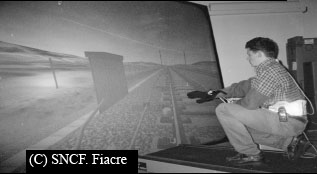
As you may know I have been involved in the creation of two VR training simulators for the french railways.
I think that learning is the most useful usage of VR. It’s not about money, it’s not about optimizing processes, it’s about empowering people.
This article by Meredith Bricken from the Human Interface Technology Lab at Washington is about the use of Virtual Environments (VEs) as Learning Environments. It was published in 1991 but most of it is still relevant.
For a more recent approach on Learning in VR, you can refer to Daniel Mellet d’Huart’s thesis.
Here’s a summary of M. Bricken’s article :
“I will describe several key attributes of VR environments and discuss them in relationship to educational theory and pedagogical practice. I will then identify three challenges that must be met before VR can be integrated into educational settings: cost, usability, and fear of the technology.
VR provides a testbed for exploring the very foundations of education.
(…)
VR was successfully developed to facilitate learning and task performance for over 20 years in the U.S. Air Force [Furness 1978].
- VR is experiential
(…)
Educational theorists have agreed on the fundamental importance of experiential learning for over a hundred years: “Learning is the development of experience into experience.” [James 1892] “Knowledge begins with enaction.” [Bruner 1962] “To learn is to make sense out of experience.” [Silberman 1970](…)
Text, oral, and screen-based presentations address subsets of human capacity. In contrast, the VR learning environment provides a context that includes the multiple nature of human intelligence: verbal/linguistic, logical/mathematical, auditory, spatial, kinesthetic, interpersonal and intrapersonal.
- Affective learning
The importance of affective learning has been carefully explored [Kohlberg 1968, Rogers 1969]. It is apparent that we must consider the whole learner in his or her effort to attain educational goals [Belkin 1977].
(…)
VR provides a context for both cognitive and affective learning by engaging us in a process that is rational and emotional, practical and whimsical, organized and spontaneous.
(…)
- The VR learning environment allows intuitive human-computer interaction
(…) This method of representing and interacting with information is fundamentally different from the way we are now using computers. Novices require minimum accommodation time [M. Bricken 1990].
(…)
The motivation to learn hinges on interest, and most people find VR a very interesting experience.
- The VR learning environment is a shared experience.
Virtual worlds can be both individual and social contexts. (…) “The learner tends to be more productive in a group situation than working in isolation.(…) [Belkin 1977]
- VR learning environments allow entirely new capabilities and experiences.
This is a powerful context, in which you can control time, scale, and physical laws. Participants have unique capabilities, such as the ability to fly through the virtual world, to occupy any object as a virtual body, to observe the environment from many perspectives.
(…)
The virtual environment allows safe experiences of distant or dangerous locations and processes. We can tele-exist in a nuclear reactor or under the sea, experiment with virtual chemistry and biology and inhabit macro- and micro-cosmic systems scaled for human participation.Challenges To Be Met
[VR is expensive, but should be used in schools to improve learning, because :]
- Cost
“Learning has become the single most critical determinant of national economic competitiveness” [Perelman 1990]
[Building VEs is hard, creating interaction is hard.]
- Usability
- Fears
(…) there is anxiety about the misuse of VR and fear that the technology may have some inherently negative attributes (see the collected abstracts of the Second International Conference on Cyberspace, Santa Cruz CA, 1991)
Brenda Laurel addresses the fear of computer technology and identifies its components:
– the archtypical taboo on presuming to imitate God
– the fear of loosing identity, becoming dependent “slaves of cybernetic symbiosis”
– fear of loosing control to unidentifiable others — invisible hackers, masked tricksters, faceless corporate/governmental manipulator
– fear of abandonment: what if VR is so compelling that people donÃt want to come out, who will mind reality? If I don’t get virtual, will I be left all alone?(…)
I will suggest three approaches to reducing VR technophobia:– Education: We need first to understand what VR is and is not.
– Research and Co-development: By sharing experiences as we continue to explore, observe, evaluate and refine VR, we increase professional and public understanding of the technology.
– Historical perspective: People, individually and collectively, learn from mistakes. The big lesson of the Twentieth Century is that careless implementation of technology can cause large-scale and lasting negative effects. It is difficult to reverse the momentum of old mistakes, but it is easier to avoid new ones.
- Final word
By making VR tools and environments available to educators, we may discover more about the very process of learning. By participating in the development of VR, educators can guide the growth of the technology, and perhaps influence the course of educational change. As we test and refine this unique learning environment together, we might even hope that VR really will help us to teach more effectively, and that we will see more often that bright light of understanding in our students’ eyes.
